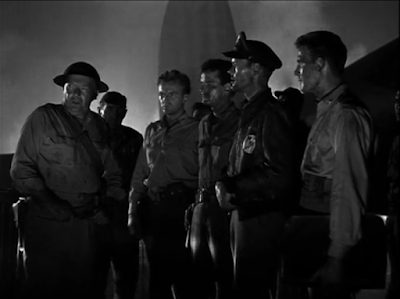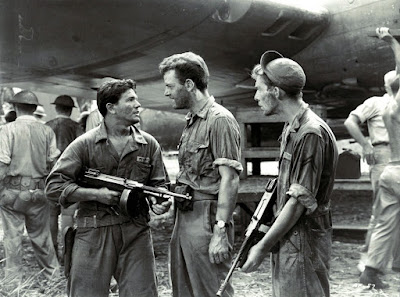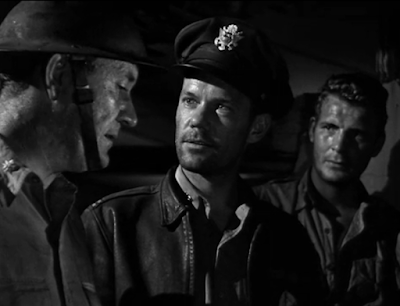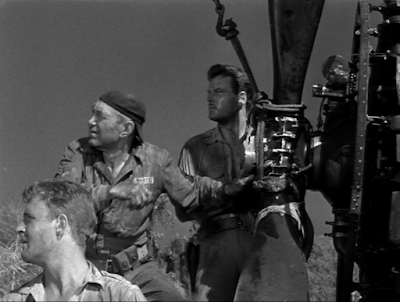Air Force (1943, directed by Howard Hawks) is absolutely propaganda. Let's make that crystal clear at the outset. Almost all war films made during the Second World War were propaganda and there was no space for anti-war sentiment in the cinema of the day. Nor was there room for criticism or pacifism in the era's politics more generally. Many such propaganda films are a drag, reducing characters into symbols without any interior life and choking on their own patriotism. This one is not like that, or not much like that, which makes it effective. It's a gripping adventure film from beginning to end, even in spite of the fact that it starts with a quote from the Gettysburg Address and ends with a speech by Franklin Delano Roosevelt. In between, though, is a pure Howard Hawks action film about his favorite types of people: Flyers. Men banded together to do a job. Professionals.
The story follows the crew of the Mary Ann, a B-17 bomber assigned to a wing in San Francisco. They've received orders for a flight to Honolulu, carrying no ammunition. It's a training exercise. The crew don't know their destination at the outset. The crew include a new tail gunner who is disgruntled with the army and plans to muster out when his tour is over in a few weeks, a radio man living up to the legacy of his legendary father, a chief mechanic whose boy is an aviator in the Philippines, a co-pilot who hopes to see his sister in Hawaii, a newlywed captain who kisses his wife goodbye on the tarmac. There is no hint that they are flying into danger, but when they arrive at Hawaii, they find Hickam Airfield and Pearl Harbor under attack by the Japanese. It's the morning of December 7, 1941. Their entire wing is redirected to alternate landing fields. The Mary Ann lands on Maui, only to come under fire from suspected fifth columnist Japanese agents. They are obliged to take to the air again and land at the ruins of Hickam Field, where they receive new orders. They must fly to the Philippines via Wake Island to help relieve American forces. The Japanese have hit Americans everywhere in the Pacific. While they wait to refit for the flight, the co-pilot discovers that his sister has been gravely injured in the attack, while her boyfriend is unscathed. The co-pilot blames him for his sister's misfortune and is none too happy to have him assigned to the Mary Ann. He's a fighter pilot, and the Philippines needs pilots. When they find out that he was one of the only pilots off the ground in the attack and that he took out three Japanese planes when the sister was injured, the crew is mollified. At Wake Island, they find more of the same, with the American personnel there grim and resigned to an impending Japanese invasion. The tail gunner and mechanic take on the marines' dog as a mascot and promise to deliver him to the marines in the Philippines. The dog becomes their own mascot, especially once they reach their destination and join the war...
Let's start with the negative. As propaganda, this film understands in its bones that racism is the way to motivate Americans to do anything. And this film is very racist.* A key part of its plot involves fifth columnists in Hawaii aiding the Japanese attack. In the film, the Mary Ann is directed to an alternate landing spot on Maui where they are chased off the island by Japanese snipers. At Hickam Field proper on Oahu, the co-pilot's sister was injured not by the hail of ordinance from the Japanese planes, but by a fifth columnist on the ground. All of this is an ugly libel. There was no Japanese fifth column activity on Hawaii leading up to or during the Pearl Harbor attack or afterward, but paranoia--which this film stokes with ruthless efficiency--is what led the United States to round up Japanese Americans and put them into concentration camps. The on-screen hatred exhibited by the cast's designated hothead--played by John Garfield--is palpable and contagious. When the younger gunner is platooned to a smaller fighter and is obliged to abandon ship, he's shot as a helpless parachuter by a Zero. This prompts Garfield's Sgt. Wynocki to exclaim "Dirty--" when he blasts the offending plane out of the sky. The film leaves it for the viewer to fill in the word after "dirty." There is a definite intention in this film to render the Japanese simultaneously inhuman and less competent than the American Air Force. I understand that it's easy for me to question this 80 years later. Doubtless, the makers of this film and the American military had no such second thoughts in the face of an existential threat. It hasn't aged well, though, and may explain why this film isn't discussed much in conversations about Howard Hawks's great films from the period. Hawks was on a roll at the time, making classic after classic (the five films that precede this in his filmography are: Bringing Up Baby, Only Angels Have Wings, His Girl Friday, Sergeant York, and Ball of Fire). Purely in terms of its craft, this film plays at that same level. Unfortunately, this one is tarnished and for some contemporary viewers all of this will be a deal breaker. I'm not going to try to convince anyone otherwise.
If the propaganda elements of Air Force are not a dealbreaker, then this is a great director at the summit of his abilities. It's astonishing how gripping this film is considering its first half is basically a long plane ride. This film is a good example of Hitchcock's ticking bomb hypothesis. Put a bomb under the table, show it to the audience, watch the characters talk about anything else, and voila! Suspense. The ticking bomb at the outset of the film is the date. The Mary Ann and its bomber wing depart for Honolulu on December 6, 1941, a fact that is shown to the audience by the writing in the logbook. The characters don't know what they're flying into, but the audience does. The bomb is set, and the audience is primed. The second half of the film provides its characters with two different kinds of problems. The first is finding Wake Island and hoping they can land there before running out of fuel. The second is getting the Mary Ann repaired and airworthy after its first mission in the Philippines before the Japanese overwhelm them. There are a couple of side stories that concern the individual characters running in parallel here, but they're all subsumed by the clock the film has set on its action. This is a plot-driven film, though the crucible of the plot dictates the evolution of the characters.
This isn't a film about movie stars even though John Garfield was a huge star at the time. This was an all hands on deck for the war effort kind of film. Hawks said of Garfield in Hawks on Hawks by Joseph Citro:
"He came around and said he wanted to be in it. And I said, 'I haven't got much for you. You're just gonna be one of the crew.' He said, 'That's all I want to be.' And as a matter of fact, he's about the only well-known actor in it. Well, Harry Carrey--"
Most of the actors were volunteers. Some of them, like Gig Young and Arthur Kennedy, were on their way to bigger things. Hawks emphasized the nature of the film by listing the cast by their jobs in the credits, rather than by the names of their characters, but he had an eye for faces and an eye for talent. Even so, Garfield had the "it" quality of a movie star, and it's hard not to notice him. He has a fairly showy part, too. Joe Wynocki is memorable for his bitterness and his turnaround in the face of an existential threat to his country. The character is so indelible that he played a variant in Destination Tokyo later in 1943. He's referenced in the monologue Christopher Walken gives to young Butch in Pulp Fiction concerning the provenance of Butch's watch, which is a deep cut. Garfield doesn't try to steal the film, though. He's on board with the program. This is a collective effort and the progressive Garfield was down for that.
This is a film about communities formed around men doing their jobs. In Hawks's universe, each man is a professional and the team is only as good as its weakest man. He valued anyone who showed up for the job and did it with no muss and fuss. Even Wynocki does his job even though the film (and audience) initially distrust him because he wants out of doing it at the outset. His pride of work in the second half of the film, bloodthirsty though it is, is the means for his redemption. It's his idea to saw off the tail cone of the plane and put a machine gun there, and he's the reason the plane survives to fight on after its first action. This is a major theme in Hawks's work, maybe THE major theme in his work. It certainly informs the way he blocks actors and stages scenes. One of the distinctive visual textures of Hawks's work--why they're so interesting to look at even when nothing in particular is on screen--is the way he just packs the frame with human beings. One-shots of solitary actors are not as common in Hawks's films as they are in other films. When they occur in his films, it's often to indicate an outsider, as one-shots of John Garfield in Air Force often indicate. If an actor signed up to work with Hawks, he was signing on to an ensemble, even if that actor was Cary Grant or John Wayne. This has propaganda value in Air Force, because the visual image of men from all walks of life from across the country coming together to do a job aligned with the military needs of the war effort. The subplot with Lt. Rader is a key element of this, in so far as he's a solitary pursuit pilot who is subsumed into the collective of the Mary Ann's crew for the greater good. Hawks is generous with scenes for his individual characters, though. The scene where Harry Carey's Sgt. White learns the fate of his son in the Philippines only to have no time to grieve is a fine bit of acting. So is Captain Quinncannon's death scene after Wynocki pilots the crippled Mary Ann back to base. This last was written by an unbilled William Faulkner. But it's in scenes with multiple characters talking over one another that the film really shines. Hawks had refined his technique of overlapping dialogue to a fine art by this time and he uses it to move the plot along at a fierce clip.
Hawks was not happy with the concluding battle scene, which he felt went on too long. Most of that sequence was assembled by producer Hal Wallis and the film went out before Hawks had a chance to cut it down. This sequence strikes a false note because the events it depicts don't fit the timeline of the film. This battle most closely resembles the Battle of the Coral Sea, which took place in mid-1942, while the film was being shot. This is the film at its most flag-waving. The events of the film previously--the attack on Pearl Harbor, the grim fate of Wake Island, the invasion of the Philippines--all represented defeats for the American forces. Moreover, Hawks made a point of killing off every character who was seen off by their loved ones at the airfield at the start of the film. He knew that war was a meat grinder. He was the man who made The Dawn Patrol, after all. By shoehorning in a victory that hadn't taken place in the film's timeline, the film aims to uplift an audience who are under a cloud of anxiety over the relentless bad news of the early war. For what it's worth, the Allies "lost" or at the very least fought to a draw in the Battle of the Coral Sea, though it paid unexpected dividends at the Battle of Midway. I think Hawks bristled at this kind of fantasy . He was at pains to depict things he knew and events he could justify. He couldn't exactly justify the wish-fulfillment of this film's final battle, at least not inside the confines of the story he wanted to tell. But that's not why the film was made and Hawks knew it. He needed the military's blessing to get the film made at all, so he swallowed it. Other things he wouldn't swallow. He almost walked off the picture when it became clear that General Curtis Le May wanted a film about long range bombers (eventually made as Strategic Air Command). Hawks wanted to make a film about his own interests. He got his way in spite of some compromises, but he never worked with Hal Wallis again.
In spite of its narrative flaws, Air Force remains a terrific picture. Even though Hawks intended that there be no movie stars as such, the film had a secret weapon in cinematographer James Wong Howe. It's hard to overstate just how good this film looks. There's an element of noir to it given the time it was made, but there's more than that. There's a poetry to the way Howe shoots things, particularly in the early parts of the film, watching planes take off just before dawn in an absolutely gorgeous crepuscular light. The night-time airfields at Hickam and Wake Island are an exercise in outright expressionism which may have roots in a need to disguise sets, but which nevertheless conveys the dire circumstances of the aftermath of the attack in ways that more elaborate daylit sets might miss. The faces Howe has to work with are distinctive, too. John Garfield in particular had a face for film noir; both hard and soft at once with angles that could be shot with expressive shadows. Howe feels this instinctively. His camera loves Garfield. It loves Harry Carrey and George Tobias, too, and to a lesser extent the more baby-faced cabin crew played by John Ridgely, Gig Young, and James Brown (not that James Brown, natch). Even in sunlit scenes, Howe pulls things toward expressionism. This all works in tandem with Hawks's blocking that makes for a film that is absolutely gorgeous on a scene by scene level.
I understand all too well why Air Force has fallen into neglect while Hawks's other films from the same era endure as classics. I don't question it. Every generation has a right to view old films through their own set of values. For myself, though? I like it a lot. It's not entirely uncritical of war even if it's not explicitly anti-war. I think it's a key film in its director's output, and it's probably better than some of his more well-known films (I'm looking at you, Sergeant York). My dad was a twenty year Air Force master sergeant who was a veteran of Korea and Vietnam. I think he would have liked this film. I have no idea if he ever saw it, though. I would have liked watching it with him.
*Anti-Japanese racism was a feature not a bug in World War II propaganda. Without excusing it, in the grand scheme of things the racism in Air Force isn't nearly as virulent as what one finds in other propaganda of the era. If you go looking for, say, "Bugs Bunny Nips the Nips" or Disney's "Commando Duck," you'll see what I mean. The racism baked into Gregg Toland's December 7 was so bad that he was removed from the project by the Pentagon and it was retooled by John Ford, which is suggestive of a military command that at least had an awareness of the possible consequences of their actions. The war was going to end eventually and America was going to have to live in the world with Japan by and by.

This blog is supported on Patreon by wonderful subscribers. If you like what I do, please consider pledging your own support. It means the world to me.

























No comments:
Post a Comment